Evaluation of Peak Shaving and Valley Filling Efficiency of Electric Vehicle Charging Piles in Power Grids
Abstract
1. Introduction
2. Theoretical Framework and Methodology
2.1. Theoretical Framework
- (1)
- To validate whether the proposed EV charging strategy contributes to peak shaving and valley filling, we first employ a Vector Autoregression (VAR) model. The charging volume data are divided into three temporal groups: the combined charging volume from 22:00 to 24:00 and 0:00–8:00 (NCV); the charging volume during 11:00–13:00 (MCV); and the charging volume during all other time periods (PEAK). (To simplify the model, we consolidate the charging volumes from non-renewable energy dominant periods—which also correspond to time intervals without the lowest electricity prices—into a single variable labeled PEAK). These groupings serve as key variables in the VAR analysis to assess dynamic interactions and grid load-shifting effects. If mutual influences exist among these variables, it would justify the comparative analysis of EV peak shaving and valley filling efficiency.
- (2)
- Similarly, using time series data, we proceed to a monthly efficiency comparison. At this stage, we introduce the Malmquist-Luenberger measure to evaluate whether efficiency in peak shaving and valley filling at EV charging piles has improved. A value greater than 1 indicates an improvement in efficiency, while a value less than 1 denotes a decline in efficiency.
- (3)
- Subsequently, we computed the overall efficiency, pure efficiency, and scale efficiency for each of the eight types of charging piles using panel data. Based on these results, we further quantified their redundancy during peak grid load periods and shortfalls during off-peak hours.
- (4)
- Finally, we conducted a scenario analysis of the peak shaving and valley filling efficiency of EV charging piles using the DDF model by scaling the charging volume during off-peak periods to 1.2, 1.5, 2, and 2.5 times the baseline level.
2.2. Methodology
2.2.1. Analysing Interrelationships in Charging Volume Using a VAR Model
2.2.2. Calculation of EV Peak Shaving and Valley Filling Efficiency
- (1)
- Explicit slack variables.
- (2)
- Incorporation of grid stability impacts.
- (3)
- Avoidance of prescriptive functional forms of the production function.
- (4)
- Robustness to data properties.
- (5)
- Handling multi-output settings.
3. Results
3.1. Characterisation of Peak Shaving and Valley Filling Efficiency in EV Charging Piles
3.2. The VAR Model Demonstrates the Feasibility of Utilising EV for Peak Shaving and Valley Filling Efficiency
3.3. Temporal Variation in Peak Shaving and Valley Filling Efficiency of EV Charging Piles
3.4. Decomposition of Peak Shaving and Valley Filling Efficiency by Charging Piles
- (1)
- BS and ESD charging piles exhibit the highest peak shaving and valley filling efficiency, achieving the top performance in both pure efficiency and scale efficiency. Their efficiency values are equal to or approach 1. Furthermore, these charging piles maintained TE = 1 for ten or more months, with some operating at full efficiency year-round.
- (2)
- Although WM’s average overall efficiency and pure efficiency in peak shaving and valley filling both reached a value of 1, its average scale efficiency remained at only 0.8631. The number of months in which TE = 1 is only 6.
- (3)
- The overall average efficiency values for IP and TA are 0.949 and 0.941, respectively, indicating similar performance levels. However, IP demonstrates lower scale efficiency compared to TA, along with fewer months achieving both TE = 1 and PTE = 1.
- (4)
- The overall average peak shaving and valley filling efficiency values for GA, P, and SM are 0.856, 0.761, and 0.772, respectively. Although GA exhibits higher overall efficiency, its scale efficiency values are relatively similar—0.944, 0.914, and 0.936.
3.5. Sensitivity Analysis of Peak Shaving and Valley Filling Efficiency in EV Charging Piles
4. Discussion
5. Conclusions
- (1)
- Efficiency is highly sensitive to seasonal and operational factors: Improving the efficiency of EV charging to support peak shaving and valley filling requires not only expanding infrastructure but also optimising operational management to align with seasonal variations and address coordination challenges.
- (2)
- Promote efficient models and prioritise remediation of low-performance sites: Emulate successful cases such as BS (effective policy guidance) and ESD (high utilisation efficiency) to extend best practices. Focus on optimising charging behaviour at low-efficiency piles such as GA, P, and SM, encouraging users to shift charging activities to off-peak periods.
- (3)
- Enhance precision in scheduling strategies: For piles such as IP that exhibit insufficient charging during specific off-peak periods, implement tailored scheduling policies to improve valley filling performance.
- (4)
- Sensitivity analysis identifies IP and TA as priority optimisation targets. These piles combine two key characteristics: room for improvement and significant potential, meaning that optimising their layout and guiding strategies can yield the highest return on investment. Piles such as GA, P, and SM remain key targets for remediation, as they are currently the primary sources of inefficiency. Due to its inherent exclusivity in usage, WM offers limited potential for improvement under this strategy and thus has a lower optimization priority.
- (1)
- Limited factor analysis: The current efficiency analysis considers only time and charging station characteristics. Future research could incorporate data on EV user behavior and charging habits to enhance the accuracy of peak shaving and valley filling efficiency evaluations.
- (2)
- Efficiency application: While this study focuses on efficiency measurement, future work could treat efficiency as an explanatory variable to explore its impact on EV adoption or RESs development, thereby expanding the conceptual and practical implications.
- (3)
- Neglect of convenience factors: The study does not account for the convenience of charging pile locations. Subsequent research could integrate geographical factors (e.g., proximity to workplaces or residential areas) into the analysis, contingent on data accessibility.
6. Implications
- (1)
- An integrated program of EV charging infrastructure is essential.
- (2)
- Formulate dynamic and incentive-based policies.
- (3)
- Optimize targeted infrastructure.
- (4)
- Promoting high-efficiency charging piles
Author Contributions
Funding
Data Availability Statement
Conflicts of Interest
References
- Li, Y.; Huang, Y.; Liang, Y.; Song, C.; Liao, S. Economic and carbon reduction potential assessment of vehicle-to-grid development in Guangdong province. Energy 2024, 302, 131742. [Google Scholar] [CrossRef]
- Ullah, Z.; Wang, S.; Wu, G.; Hasanien, H.M.; Rehman, A.U.; Turky, R.A.; Elkadeem, M.R. Optimal scheduling and techno-economic analysis of electric vehicles by implementing solar-based grid-tied charging station. Energy 2023, 267, 126560. [Google Scholar] [CrossRef]
- Li, X.; Wang, Z.; Zhang, L.; Sun, F.; Cui, D.; Hecht, C.; Figgener, J.; Sauer, D.U. Electric vehicle behavior modeling and applications in vehicle-grid integration: An overview. Energy 2023, 268, 126647. [Google Scholar] [CrossRef]
- Yao, Z.; Ran, L.; Wang, Z.; Guo, X. Integrated management of electric vehicle sharing system operations and Internet of Vehicles energy scheduling. Energy 2024, 309, 132498. [Google Scholar] [CrossRef]
- Wesseh, P.; Benjamin, N.; Lin, B. The coordination of pumped hydro storage, electric vehicles, and climate policy in imperfect electricity markets: Insights from China. Renew. Sustain. Energy Rev. 2022, 160, 112275. [Google Scholar] [CrossRef]
- Dixon, J.; Bukhsh, W.; Edmunds, C.; Bell, K. Scheduling electric vehicle charging to minimise carbon emissions and wind curtailment. Renew. Energy 2020, 161, 1072–1091. [Google Scholar] [CrossRef]
- Borba, B.; Szklo, A.; Schaeffer, R. Plug-in hybrid electric vehicles as a way to maximize the integration of variable renewable energy in power systems: The case of wind generation in northeastern Brazil. Energy 2012, 37, 469–481. [Google Scholar] [CrossRef]
- Liu, L.; Kong, F.; Liu, X.; Peng, Y.; Wang, Q. A review on electric vehicles interacting with renewable energy in smart grid. Renew. Sustain. Energy Rev. 2015, 51, 648–661. [Google Scholar] [CrossRef]
- Zhao, Z.; Zhang, L.; Yang, M.; Chai, J.; Li, S. Pricing for private charging pile sharing considering EV consumers based on non-cooperative game model. J. Clean. Prod. 2020, 254, 120039. [Google Scholar] [CrossRef]
- Wang, N.; Tian, H.; Zhu, S.; Li, Y. Analysis of public acceptance of electric vehicle charging scheduling based on the technology acceptance model. Energy 2022, 258, 124804. [Google Scholar] [CrossRef]
- Reibsch, R.; Gemassmer, J.; Katerbau, T. Low voltage grid resilience: Evaluating electric vehicle charging strategies in the context of the grid development plan Germany. eTransportation 2024, 20, 100323. [Google Scholar] [CrossRef]
- Sagaria, S.; Kam, M.; Bostrom, T. The influence of socio-technical variables on vehicle-to-grid technology. Energy 2024, 305, 132299. [Google Scholar] [CrossRef]
- Zambrano-Monserrate, M.; Soto, G.; Ahakwa, I.; Manigandan, P. Dynamic effects on modern renewable energy generation: The role of patents in clean energy technology. Energy 2024, 311, 1133340. [Google Scholar] [CrossRef]
- Sandstrom, M.; Huang, P.; Bales, C.; Dotzauer, E. Evaluation of hosting capacity of the power grid for electric vehicles—A case study in a Swedish residential area. Energy 2023, 284, 129293. [Google Scholar] [CrossRef]
- Kester, J.; Noel, L.; de Rubens, G.Z.; Sovacool, B. Promoting Vehicle to Grid (V2G) in the Nordic region: Expert advice on policy mechanisms for accelerated diffusion. Energy Policy 2018, 116, 422–432. [Google Scholar] [CrossRef]
- Zhang, Y.; Xu, T.; Chen, T.; Hu, Q.; Chen, H.; Hu, X.; Jiang, Z. A high-resolution electric vehicle charging transaction dataset with multidimensional features in China. Sci. Data 2025, 12, 643. [Google Scholar] [CrossRef]
- Liu, P.; Li, M.; Han, C.; Meng, L.; Shao, Z. From input to output: Unraveling the Spatio-temporal pattern and driving factors of the coupling coordination between wind power efficiency and installed capacity in China. Appl. Energy 2025, 396, 126320. [Google Scholar] [CrossRef]
- Santos-Arteaga, F.J.; Buendía, A.; André, F.J. A dynamic approach to analyze the evolution of water use efficiency across Spanish regions. J. Environ. Manag. 2025, 389, 126174. [Google Scholar] [CrossRef] [PubMed]
- Fare, R.; Desli, E. Productivity growth, technical progress, and efficiency change in industrialised countries: Comment. Am. Econ. Rev. 1997, 87, 1033–1039. [Google Scholar]
- Lei, X.; Zhong, J.; Chen, Y.; Shao, Z.; Jian, L. Grid integration of electric vehicles within electricity and carbon markets: A comprehensive overview. eTransportation 2025, 25, 100435. [Google Scholar] [CrossRef]
- Madhan-akkumar, N.; Vijayaragavan, M.; Anbarasan, P.; Reshmila, S. Smart energy management for plug-in hybrid electric vehicles: Integration of waterwheel plant algorithm and dual stream spectrum deconvolution neural network. J. Energy Storage. 2024, 102, 113867. [Google Scholar] [CrossRef]
- Qian, L.; Zhang, C.; Chen, Y.; Xiao, Z. Spatial cross-side network effect of charging stations on electric vehicle adoption. Transp. Res. Part. D Transp. Environ. 2024, 136, 104400. [Google Scholar] [CrossRef]
- Liu, X.; Guo, X.; Sun, X.; Song-Turner, H. Network effects from the provision of charging stations in the market diffusion of electric vehicles. Transp. Lett. 2025, 17, 881–894. [Google Scholar] [CrossRef]
- Uddin, K.; Dubarry, M.; Glick, M.B. The viability of vehicle-to-grid operations from a battery technology and policy perspective. Energy Policy. 2018, 113, 342–347. [Google Scholar] [CrossRef]
- Sabadini, F.; Madlener, R. Does taxation hamper the vehicle-to-grid business case? Empirical evidence from Germany. Appl. Energy 2025, 381, 125041. [Google Scholar] [CrossRef]
- Guo, S.; He, J.; Ma, K.; Yang, J.; Wang, Y.; Li, P. Robust economic dispatch for industrial microgrids with electric vehicle. Renew. Energy 2025, 240, 122210. [Google Scholar] [CrossRef]
- Gonul, O.; Duman, A.C.; Guler, O. Multi-objective optimal sizing and techno-economic analysis of on- and off-grid hybrid renewable energy systems for EV charging stations. Sustain. Cities Soc. 2024, 115, 105846. [Google Scholar] [CrossRef]
- Guindi, M.; Kamel, R.M. Optimal location and sizing of renewable distributed generations and electric vehicle charging stations. Renew. Energy 2024, 235, 121272. [Google Scholar] [CrossRef]
- Will, C.; Zimmermann, F.; Ensslen, A.; Fraunholz, C.; Jochem, P.; Keles, D. Can electric vehicle charging be carbon neutral? Uniting smart charging and renewables. Appl. Energy 2024, 371, 123549. [Google Scholar] [CrossRef]
- Katontoka, M.; Orsi, F.; Bakker, M.; Hocks, B. Toward sustainable transportation: A systematic review of EV charging station locations. Int. J. Sustain. Transp. 2025, 19, 881–893. [Google Scholar] [CrossRef]
- Osaki, F.; Fujimoto, Y.; Iino, Y.; Ihara, Y.; Mitsuoka, M.; Hayashi, Y. Dynamic bus charge scheduling by model predictive control to maximize local PV surplus power utilization. eTransportation 2025, 25, 100441. [Google Scholar] [CrossRef]
- Chen, Z.; Ji, Y.; Guo, Z.; Pei, H.; Zhou, Z. A method for allocation of supply-demand equilibrium in urban electric vehicles shared charging facilities. Sustain. Cities Soc. 2025, 131, 106682. [Google Scholar] [CrossRef]
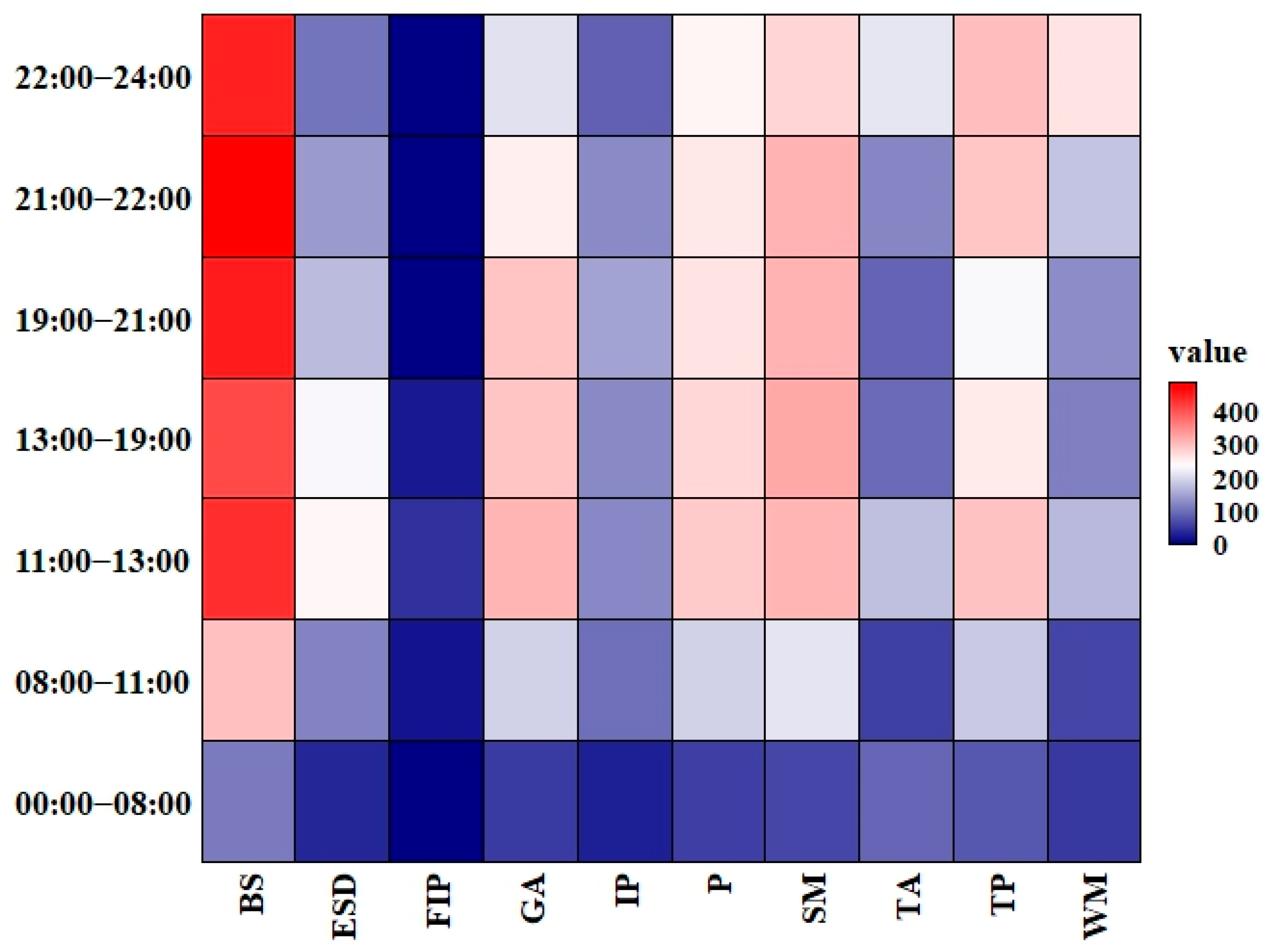
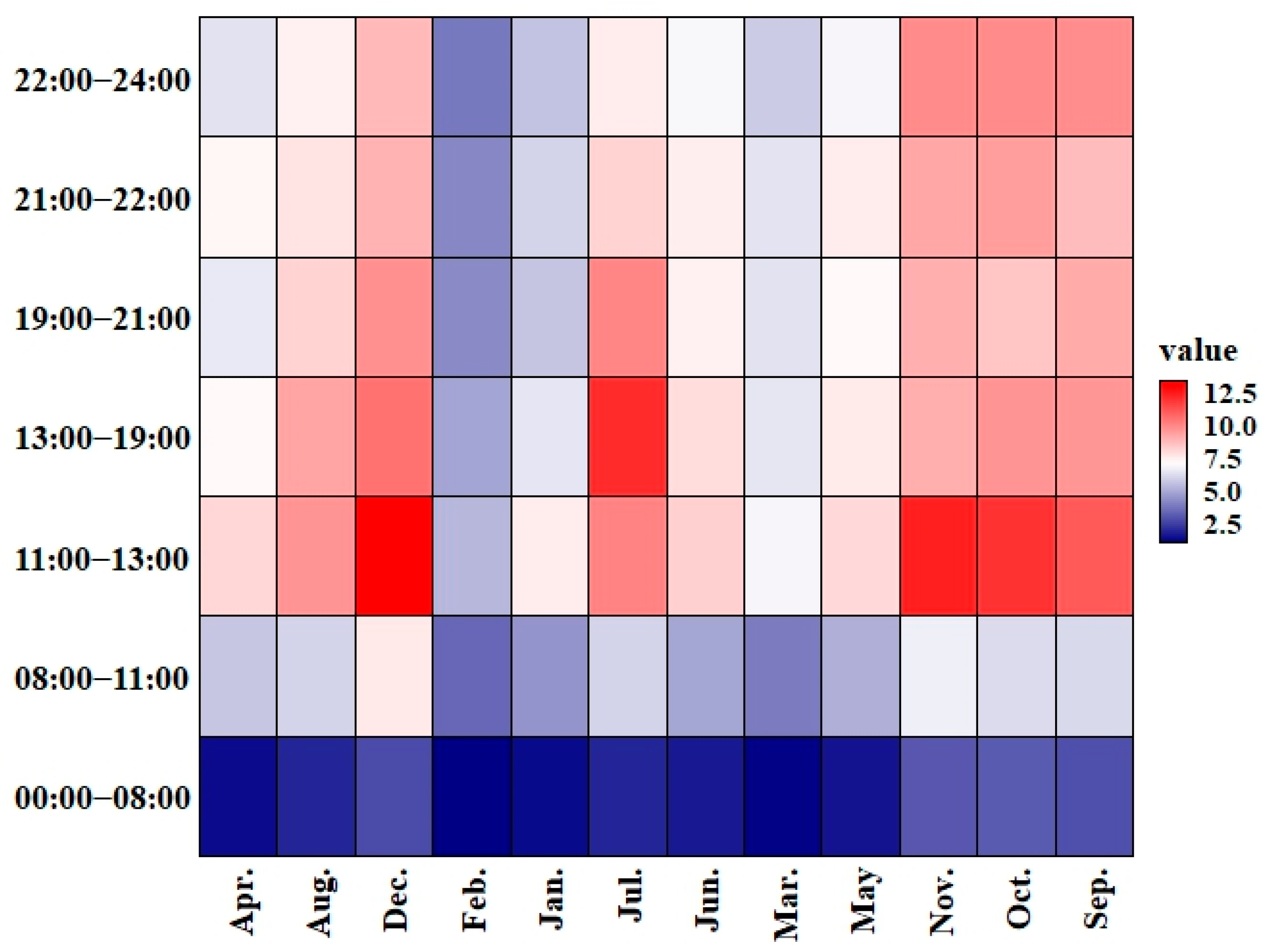
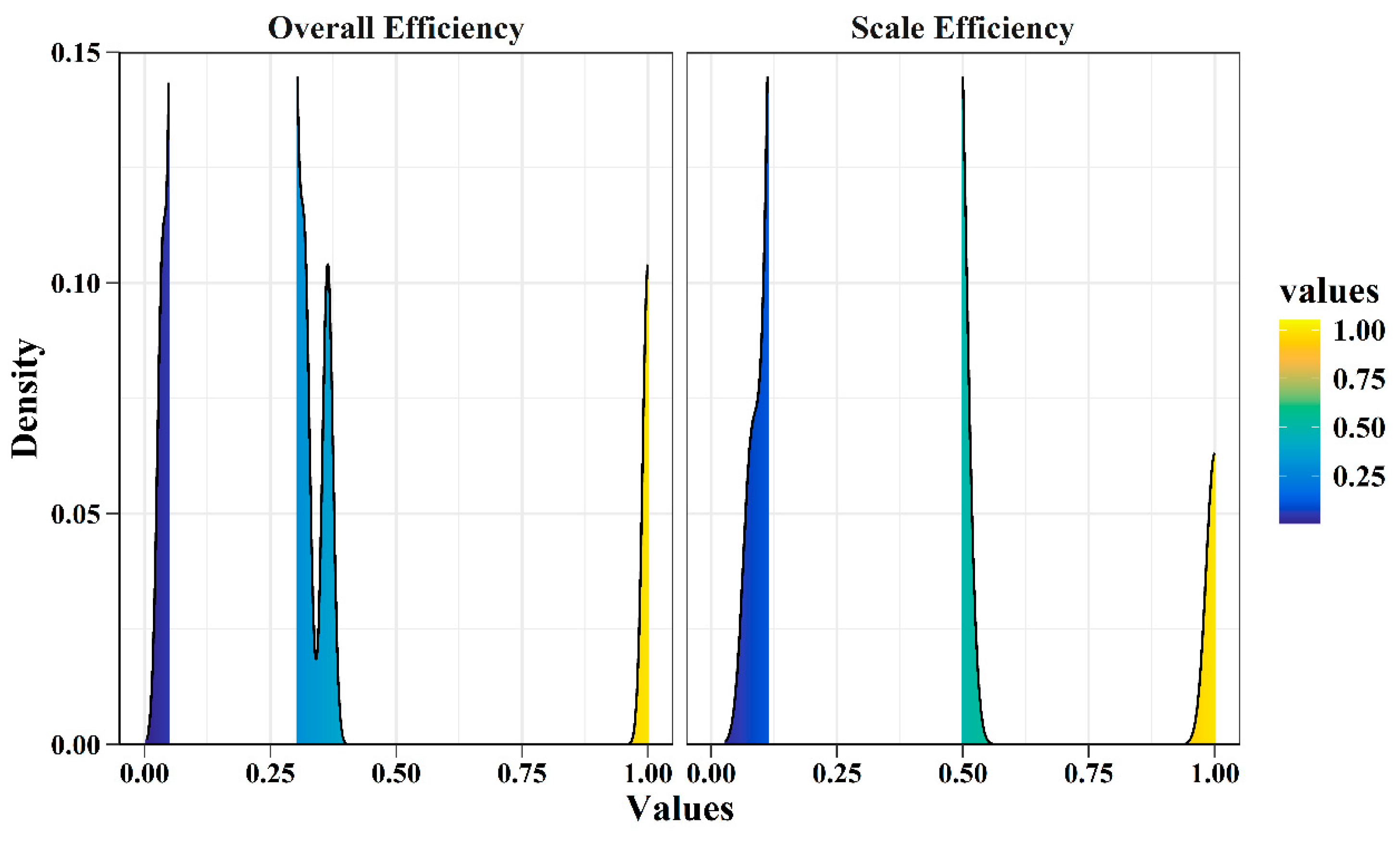
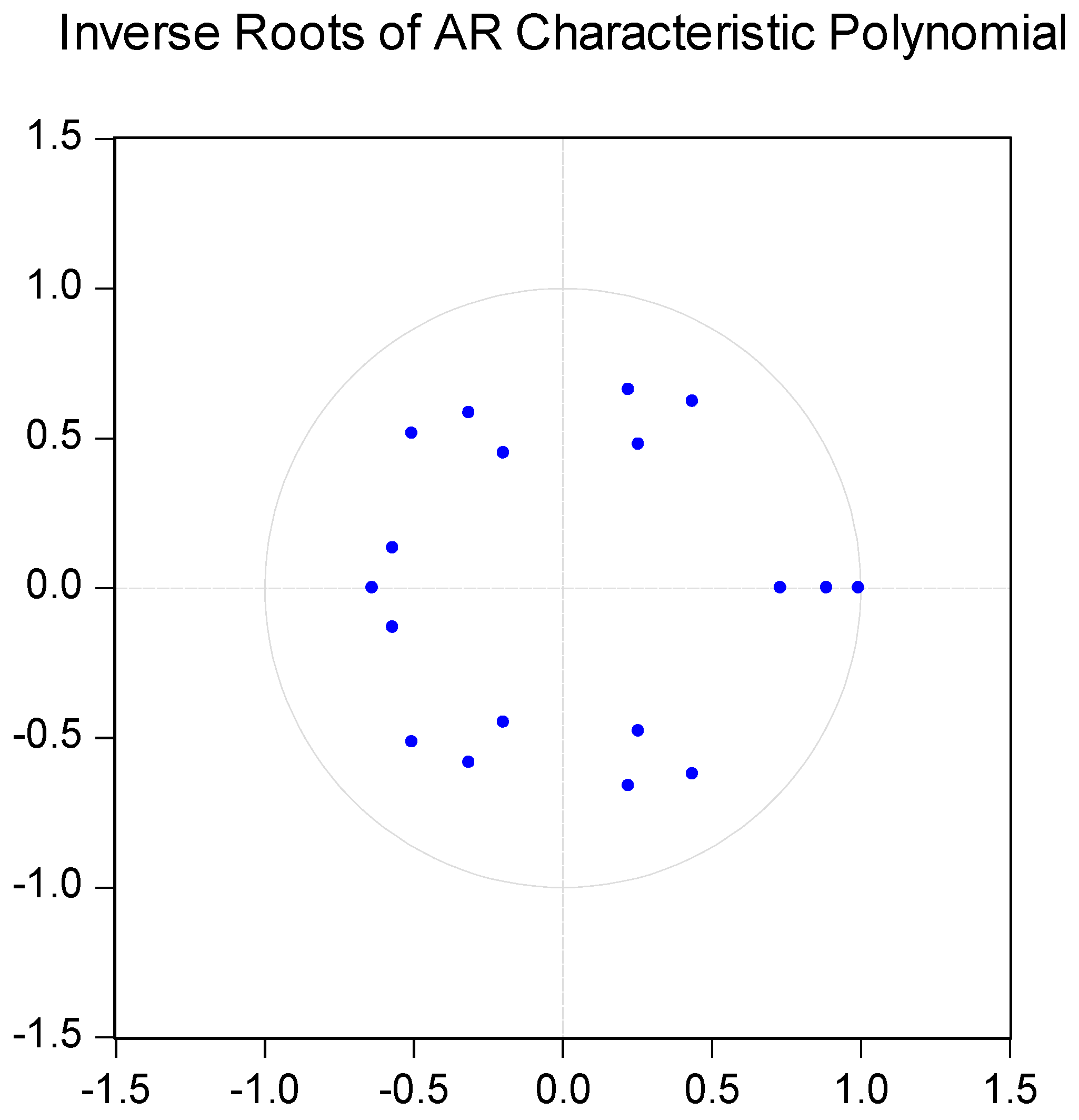
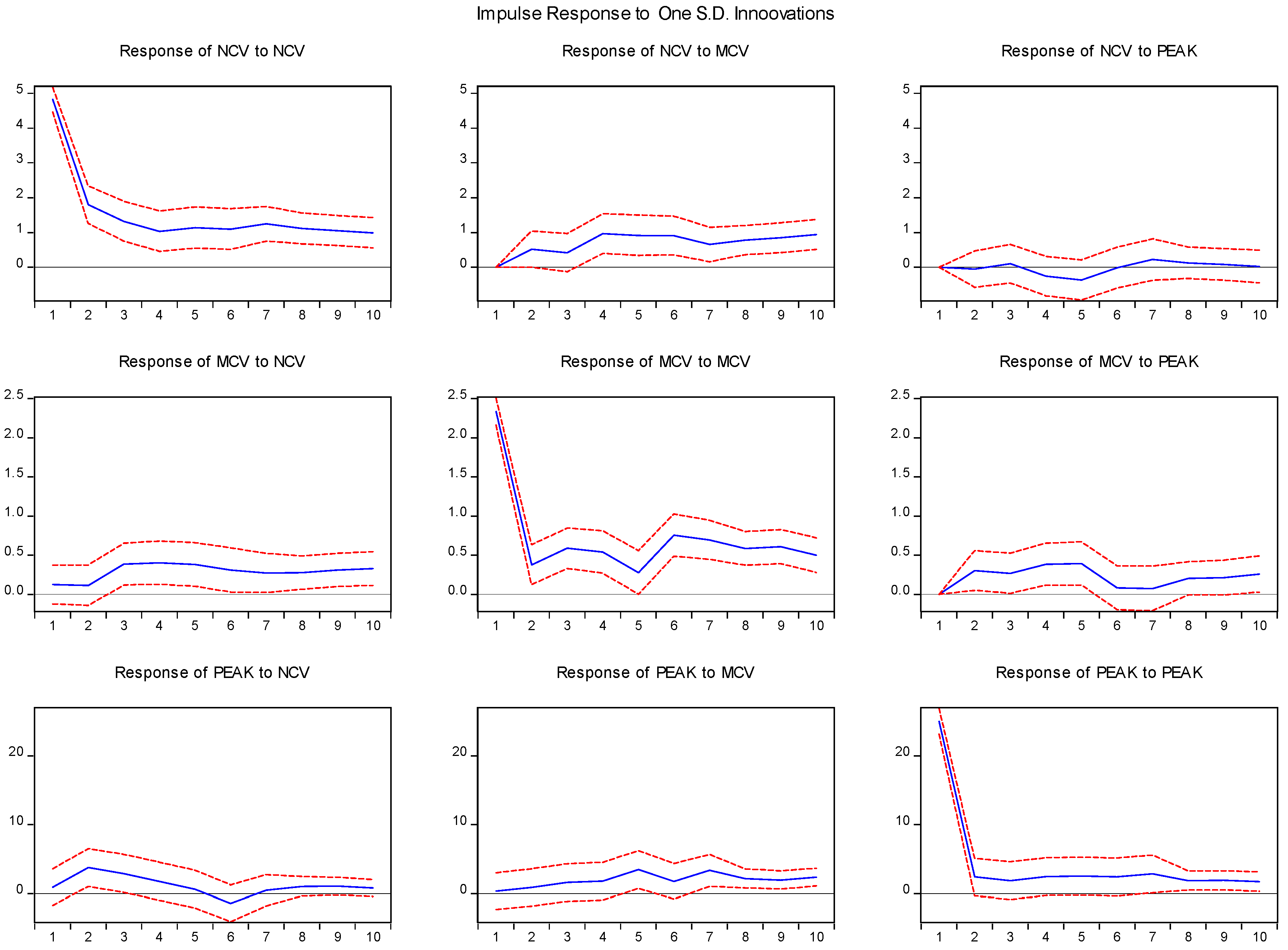
| Time Intervals | Electricity Price (Yuan/kWh) | Off-Peak Charging Period | Definition of Charging Volume | Variable |
|---|---|---|---|---|
| 00:00–08:00 | 0.3784 | Yes | outputs | Out1 |
| 08:00–11:00 | 0.9014 | No | inputs | Inp1 |
| 11:00–13:00 | 0.3784 | Yes | outputs | Out2 |
| 13:00–19:00 | 0.9014 | No | inputs | Inp2 |
| 19:00–21:00 | 1.2064 | No | inputs | Inp3 |
| 21:00–22:00 | 0.9014 | No | inputs | Inp4 |
| 22:00–24:00 | 0.3784 | Yes | outputs | Out3 |
| Augmented Dickey–Fuller Test | Phillips–Perron Test | Kwiatkowski–Phillips–Schmidt–Shin Test | ||||
|---|---|---|---|---|---|---|
| t-Statistic | p-Value | t-Statistic | p-Value | LM-Statistic | Critical Value at the 5% Level | |
| MCV | −8.394 | 0.000 | −15.527 | 0.000 | 0.162 | 0.146 |
| NCV | −7.106 | 0.000 | −12.170 | 0.000 | 0.130 | 0.146 |
| PEAK | −16.149 | 0.000 | −17.085 | 0.000 | 0.192 | 0.146 |
| Constant | Yes | Yes | Yes | |||
| Trend | Yes | Yes | Yes | |||
| NCV(−1) | NCV(−2) | NCV(−3) | NCV(−4) | NCV(−5) | |
|---|---|---|---|---|---|
| NCV | 0.367 * | 0.131 * | 0.042 * | 0.088 * | 0.043 * |
| MCV | 0.018 ** | 0.053 ** | 0.023 ** | 0.002 ** | −0.017 ** |
| PEAK | 0.752 | 0.215 | −0.087 | −0.296 | −0.638 |
| MCV(−1) | MCV(−2) | MCV(−3) | MCV(−4) | MCV(−5) | |
| NCV | 0.224 | 0.062 | 0.255 | 0.109 | 0.058 |
| MCV | 0.160 * | 0.216 * | 0.128 * | −0.034 * | 0.162 * |
| PEAK | 0.361 | 0.410 | 0.322 | 0.755 | −0.166 |
| PEAK(−1) | PEAK(−2) | PEAK(−3) | PEAK(−4) | PEAK(−5) | |
| NCV | −0.002 ** | 0.002 ** | −0.015 ** | −0.017 ** | 0.001 ** |
| MCV | 0.012 *** | 0.008 *** | 0.009 *** | 0.007 *** | −0.006 *** |
| PEAK | 0.095 * | 0.062 * | 0.074 ** | 0.072 ** | 0.056 ** |
| Month | Efficiency Change (EC) | Scale Efficiency Change (SEC) | Malmquist |
|---|---|---|---|
| 1–2 | 0.946 | 0.520 | 1.101 |
| 2–3 | 1.026 | 0.843 | 1.083 |
| 3–4 | 0.993 | 0.948 | 0.995 |
| 4–5 | 1.015 | 1.003 | 1.044 |
| 5–6 | 0.951 | 1.027 | 1.038 |
| 6–7 | 1.035 | 0.905 | 1.004 |
| 7–8 | 0.988 | 1.054 | 1.072 |
| 8–9 | 1.010 | 0.965 | 1.234 |
| 9–10 | 0.958 | 0.952 | 0.960 |
| 10–11 | 0.988 | 1.059 | 1.126 |
| 11–12 | 1.082 | 0.933 | 1.064 |
| Effect Type | Mean Value and Number of Months | BS | ESD | GA | IP | P | SM | TA | WM |
|---|---|---|---|---|---|---|---|---|---|
| Overall Efficiency | Mean Value | 1 | 1 | 0.856 | 0.949 | 0.761 | 0.772 | 0.941 | 1 |
| Number of Months with TE = 1 | 12 | 10 | 5 | 5 | 3 | 3 | 7 | 6 | |
| Pure Efficiency | Mean Value | 1 | 1 | 0.856 | 0.949 | 0.761 | 0.772 | 0.941 | 1 |
| Number of Months with PTE = 1 | 10 | 11 | 7 | 9 | 5 | 4 | 11 | 10 | |
| Scale Efficiency | Mean Value | 1 | 0.942 | 0.944 | 0.661 | 0.914 | 0.936 | 0.865 | 0.863 |
| Number of Months with SE = 1 | 12 | 11 | 5 | 5 | 4 | 3 | 8 | 7 |
| Time Intervals | Redundant Ratio | Redundant Ratio | Shortage Ratio | Shortage Ratio |
|---|---|---|---|---|
| Below Average | Above Average | Below Average | Above Average | |
| 8–11 | BS, ESD, IP, TA, WM | GA, P, SM | - | - |
| 13–19 | BS, ESD, IP, TA, WM | GA, P, SM | - | - |
| 19–21 | BS, ESD, IP, TA, WM | GA, P, SM | - | - |
| 21–22 | BS, ESD, GA, IP, TA, WM | P, SM | - | - |
| 0–8 | - | - | BS, ESD, IP, TA, WM | GA, P, SM |
| 22–24 | - | - | BS, ESD, TA, WM | GA, IP, P, SM |
| 11–13 | - | - | BS, ESD, GA, TA, WM | IP, P, SM |
| Types of Charging Piles | Overall Efficiency | Pure Technical Efficiency | Scale Efficiency | Key Characteristics and Causes |
|---|---|---|---|---|
| BS, ESD | Highest | Highest | Highest | Benchmark Effectively implements time-of-use electricity pricing policies (BS) High infrastructure utilisation rates (ESD) |
| WM | High | High | Relatively low | High operational efficiency coupled with insufficient scale efficiency (exclusivity or dedicated usage) |
| IP, TA | Relatively high | Relatively high | Medium | Room for improvement, relatively low scale efficiency (IP) |
| GA, P, SM | Lowest | Low | Relatively low | Key optimisation targets (not located in residential or workplace areas) |
| Charging Pile | 1.2 × VF | 1.5 × VF | 2 × VF | 2.5 × VF | ||||
|---|---|---|---|---|---|---|---|---|
| Average Efficiency | Average GML | Average Efficiency | Average GML | Average Efficiency | Average GML | Average Efficiency | Average GML | |
| BS | 1.000 | 1.029 | 1.000 | 1.026 | 1.000 | 1.021 | 1.000 | 1.018 |
| ESD | 0.999 | 1.033 | 0.999 | 1.026 | 0.999 | 1.019 | 0.999 | 1.012 |
| GA | 0.961 | 1.038 | 0.969 | 1.036 | 0.977 | 1.034 | 0.981 | 1.030 |
| IP | 0.802 | 1.008 | 0.831 | 1.008 | 0.865 | 1.007 | 0.888 | 1.007 |
| P | 0.889 | 0.999 | 0.908 | 0.999 | 0.930 | 0.999 | 0.945 | 0.998 |
| SM | 0.917 | 1.006 | 0.932 | 1.005 | 0.946 | 1.004 | 0.955 | 1.004 |
| TA | 0.838 | 1.066 | 0.856 | 1.066 | 0.908 | 1.069 | 0.925 | 1.061 |
| WM | 0.979 | 1.008 | 0.982 | 1.006 | 0.985 | 1.001 | 0.987 | 0.999 |
Disclaimer/Publisher’s Note: The statements, opinions and data contained in all publications are solely those of the individual author(s) and contributor(s) and not of MDPI and/or the editor(s). MDPI and/or the editor(s) disclaim responsibility for any injury to people or property resulting from any ideas, methods, instructions or products referred to in the content. |
© 2025 by the authors. Licensee MDPI, Basel, Switzerland. This article is an open access article distributed under the terms and conditions of the Creative Commons Attribution (CC BY) license (https://creativecommons.org/licenses/by/4.0/).
Share and Cite
Wang, S.; Liu, C.; Chen, F. Evaluation of Peak Shaving and Valley Filling Efficiency of Electric Vehicle Charging Piles in Power Grids. Energies 2025, 18, 5284. https://doi.org/10.3390/en18195284
Wang S, Liu C, Chen F. Evaluation of Peak Shaving and Valley Filling Efficiency of Electric Vehicle Charging Piles in Power Grids. Energies. 2025; 18(19):5284. https://doi.org/10.3390/en18195284
Chicago/Turabian StyleWang, Siyao, Chongzhi Liu, and Fu Chen. 2025. "Evaluation of Peak Shaving and Valley Filling Efficiency of Electric Vehicle Charging Piles in Power Grids" Energies 18, no. 19: 5284. https://doi.org/10.3390/en18195284
APA StyleWang, S., Liu, C., & Chen, F. (2025). Evaluation of Peak Shaving and Valley Filling Efficiency of Electric Vehicle Charging Piles in Power Grids. Energies, 18(19), 5284. https://doi.org/10.3390/en18195284






